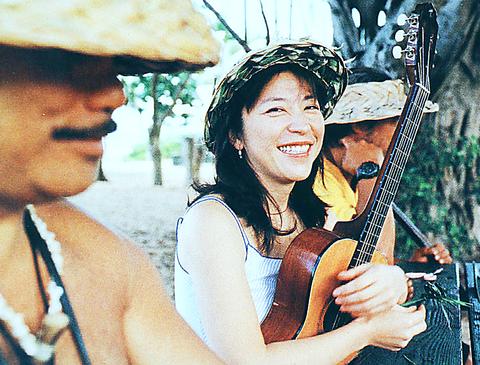When the late great Elvis Aaron Presley put the blue in Hawaii all those years ago he would have had no idea that one day a Brazilian-born Japanese woman would be bringing her own colorful brand of Blue Hawaii to Taiwan.
"Bossa Nova Hula: Lisa Ono's Blue Hawaii," the concert by singer/songwriter, violinist, acoustic guitar player, Lisa Ono, is set to have the auditorium of the Sun Yat Sen Memorial Hall swinging tonight, when the soulful-voiced jazz diva hits the stage as part of her summer tour. The concert is her only performance in Taiwan.
Born in Brazil to Japanese parents, Ono was introduced to the smoky jazz bar scene at a young age. While most of her peers were doing what normal 10 year-olds do, Ono was hanging out with her father at his popular Sao Paulo nightclub.

COURTESY OF EMI TAIWAN
After moving back to Japan, Ono's father opened the Saci Perer nightclub in Tokyo, where the teenage Ono began to perform a predominantly Brazilian repertoire of samba and bossa nova tunes. Now Ono performs many of her tunes in English and Japanese.
Dubbed the "Queen of Bossa Nova" in Japan, Ono has become one of the world's top practitioners of the mild and rhythmical form of Latin jazz.
Since debuting in 1989 with Catopili, an album on which the Sao Paulo native first began experimenting with her own style of samba and bossa nova, Ono has gone on to release 12 albums, the most successful of which being the 1999 jazz-influenced Dreams, a record which went on to sell over 200,000 copies worldwide.
Apart from selling over three million records since 1989, Ono has also been responsible for single-handedly shaping a bossa nova revival in Japan. Along the way she has collaborated with some of the biggest names in bossa nova and jazz, including "the pioneer of bossa nova" Antonio Carlos Jobim.
More recently, Ono teamed up with producer Eumir Deodato for her 2000 release, Pretty World. Deodato, who has worked with the likes of Roberta Flack, Aretha Franklin and Bjork, helped the performer add an original edge to the material on that album, which was a pot pourri of her own bossa nova interpretations of tunes by the likes of Stevie Wonder, Leon Russell and The Police. These fusions, while sounding at first rather odd have proven incredibly popular in her native Brazil, as well as in Japan.
For tonight's concert the queen of bossa nova will be performing a selection of tunes taken from her Pretty World album, which has only recently been released locally.
What: Lisa Ono Bossa Nova Hula: Lisa Ono's Blue Hawaii
When: Tonight
Where: Taipei's Dr Sun Yat Sen Memorial Hall (台北市國父紀念館), 505 Renai Rd., Sec. 4, Taipei (台北市仁愛路4段505號)
Tickets: Tickets cost between NT$900 and NT$2,500 and are available through ACER ticketing outlets or at the door.

The Taipei Times last week reported that the rising share of seniors in the population is reshaping the nation’s housing markets. According to data from the Ministry of the Interior, about 850,000 residences were occupied by elderly people in the first quarter, including 655,000 that housed only one resident. H&B Realty chief researcher Jessica Hsu (徐佳馨), quoted in the article, said that there is rising demand for elderly-friendly housing, including units with elevators, barrier-free layouts and proximity to healthcare services. Hsu and others cited in the article highlighted the changing family residential dynamics, as children no longer live with parents,

It is jarring how differently Taiwan’s politics is portrayed in the international press compared to the local Chinese-language press. Viewed from abroad, Taiwan is seen as a geopolitical hotspot, or “The Most Dangerous Place on Earth,” as the Economist once blazoned across their cover. Meanwhile, tasked with facing down those existential threats, Taiwan’s leaders are dying their hair pink. These include former president Tsai Ing-wen (蔡英文), Vice President Hsiao Bi-khim (蕭美琴) and Kaohsiung Mayor Chen Chi-mai (陳其邁), among others. They are demonstrating what big fans they are of South Korean K-pop sensations Blackpink ahead of their concerts this weekend in Kaohsiung.

Oct 20 to Oct 26 After a day of fighting, the Japanese Army’s Second Division was resting when a curious delegation of two Scotsmen and 19 Taiwanese approached their camp. It was Oct. 20, 1895, and the troops had reached Taiye Village (太爺庄) in today’s Hunei District (湖內), Kaohsiung, just 10km away from their final target of Tainan. Led by Presbyterian missionaries Thomas Barclay and Duncan Ferguson, the group informed the Japanese that resistance leader Liu Yung-fu (劉永福) had fled to China the previous night, leaving his Black Flag Army fighters behind and the city in chaos. On behalf of the

I was 10 when I read an article in the local paper about the Air Guitar World Championships, which take place every year in my home town of Oulu, Finland. My parents had helped out at the very first contest back in 1996 — my mum gave out fliers, my dad sorted the music. Since then, national championships have been held all across the world, with the winners assembling in Oulu every summer. At the time, I asked my parents if I could compete. At first they were hesitant; the event was in a bar, and there would be a lot